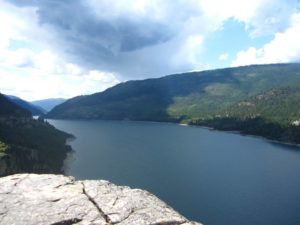Increased Spill Beginning at Federal Columbia River Power System Dams


The Ninth Circuit Court of Appeals affirmed a U.S. District Court opinion requiring the Army Corps of Engineers to increase spill at dams on the Federal Columbia River Power System (“FCRPS”) to the maximum spill levels that still meet total dissolved gas criteria allowed under state law. The increased spills required by the District Court’s order and affirmed by the Court of Appeals began on April 3, 2018. The Court of Appeals’ decision is available here.
The Court of Appeals’ decision in National Wildlife Federation v. National Marine Fisheries Service is the most recent decision in this case, which has been ongoing since 2000. The decision stems from a challenge to the National Marine Fisheries Service’s (“NMFS”) 2014 Biological Opinion (“BiOp”) that concluded operation of the FCRPS dams would jeopardize salmon and steelhead species (“listed species”) listed under the Endangered Species Act (“ESA”). Because NMFS’s BiOP concluded operation of the FCRPS dams would jeopardize the listed species, pursuant to NFMS responsibilities under the ESA, NFMS proposed an alternative action that included, among other measures, some spill over the FCRPS dams as a means to avoid jeopardizing the listed species.
However, in 2016 the District Court found NMFS’ violated the Endangered Species Act when NMFS concluded the alternative in the 2014 BiOp did not jeopardize the listed species. The District Court gave NMFS until March 1, 2018 to issue a new BiOp. (This deadline was later extended to December 31, 2018.) However, in January 2017, the plaintiffs moved for injunctive relief, requesting the District Court order additional spill at the maximum level from April through June at dams along the FCRPS. In April 2017, the District Court granted plaintiffs’ injunctions and ordered increased spills to take effect April 3, 2018. The District Court’s decision was appealed to the Ninth Circuit Court of Appeals.
The Court of Appeals issued its decision upholding the District Court’s order requiring increased spills on April 2, 2018, the day before the increased spills were to begin. The Court of Appeals found the District Court did not err under the ESA in finding the plaintiffs had shown the listed species would suffer irreparable harm sufficient to order the increased spill. Nor did the Court of Appeals find it error that the District Court analyzed the harm that would be caused to the listed species in operation of the FCRPS dams as a whole, rather than focusing only on the spill related components of the BiOp alternative NMFS selected.
As irrigation season begins in the areas of the Columbia and Snake Rivers that rely on the water flowing through the FCRPS, and as the increased spills begin to take effect, some congressional leaders in the affected states are attempting a congressional solution to negate the effects of the court decisions. House Bill 3144, introduced by Representative Cathy McMorris Rodgers (R-WA) in June 2017, reported out of the House Committee on Natural Resources on April 11, 2018. It remains to be seen if and when H.R. 3144 may be scheduled to be heard on the floor of the House of Representatives; however, the Court of Appeals’ decision has, and any outcomes from H.R. 3144 will have, immediate impacts on water rates and utility rates for irrigators and residents throughout the Pacific Northwest. H.R. 3144 is available here.
(Photo: Lake Koocanusa, Libby, MT)